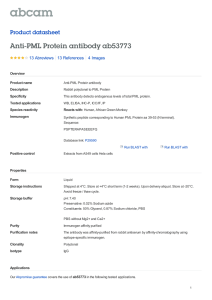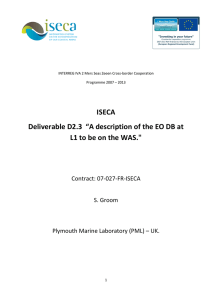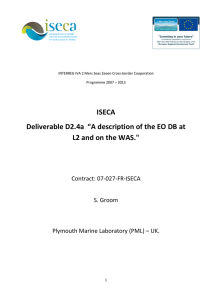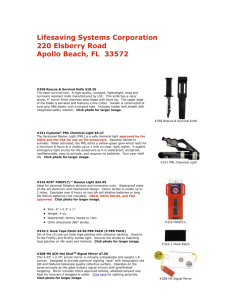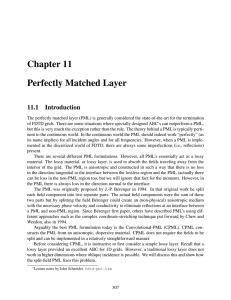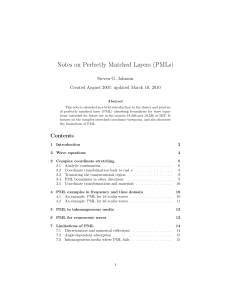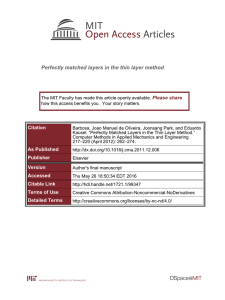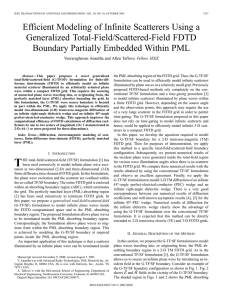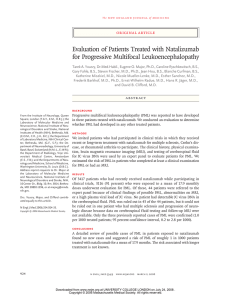Anti-PML Protein antibody ab67761 Product datasheet 2 References 1 Image
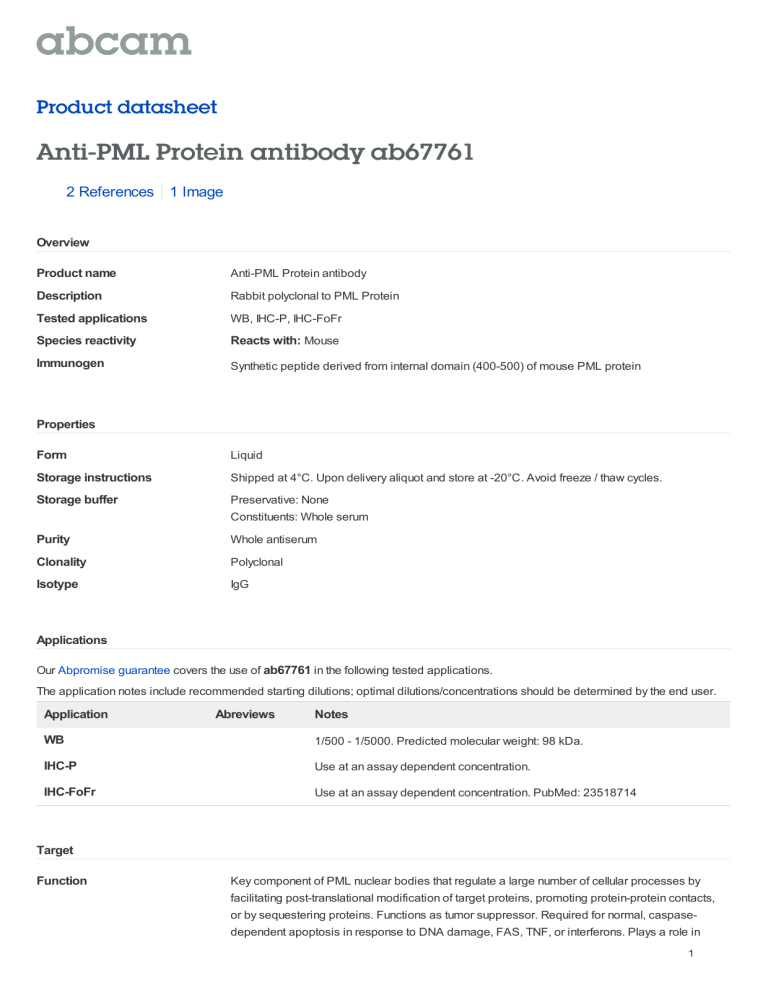
2 References 1 Image
Overview
Product name
Description
Tested applications
Species reactivity
Immunogen
Anti-PML Protein antibody
Rabbit polyclonal to PML Protein
WB, IHC-P, IHC-FoFr
Reacts with:
Mouse
Synthetic peptide derived from internal domain (400-500) of mouse PML protein
Properties
Form
Storage instructions
Storage buffer
Purity
Clonality
Isotype
Liquid
Shipped at 4°C. Upon delivery aliquot and store at -20°C. Avoid freeze / thaw cycles.
Preservative: None
Constituents: Whole serum
Whole antiserum
Polyclonal
IgG
Applications
Our Abpromise guarantee covers the use of
ab67761
in the following tested applications.
The application notes include recommended starting dilutions; optimal dilutions/concentrations should be determined by the end user.
Application Abreviews Notes
WB
IHC-P
IHC-FoFr
1/500 - 1/5000. Predicted molecular weight: 98 kDa.
Use at an assay dependent concentration.
Use at an assay dependent concentration. PubMed: 23518714
Target
Function
Key component of PML nuclear bodies that regulate a large number of cellular processes by facilitating post-translational modification of target proteins, promoting protein-protein contacts, or by sequestering proteins. Functions as tumor suppressor. Required for normal, caspasedependent apoptosis in response to DNA damage, FAS, TNF, or interferons. Plays a role in
1
Involvement in disease
Sequence similarities
Domain
Post-translational modifications
Cellular localization
transcription regulation, DNA damage response, DNA repair and chromatin organization. Plays a role in processes regulated by retinoic acid, regulation of cell division, terminal differentiation of myeloid precursor cells and differentiation of neural progenitor cells. Required for normal immunity to microbial infections. Plays a role in antiviral response. In the cytoplasm, plays a role in TGFB1-dependent processes. Regulates p53/TP53 levels by inhibiting its ubiquitination and proteasomal degradation. Regulates activation of p53/TP53 via phosphorylation at 'Ser-20'.
Sequesters MDM2 in the nucleolus after DNA damage, and thereby inhibits ubiquitination and degradation of p53/TP53. Regulates translation of HIF1A by sequestering MTOR, and thereby plays a role in neoangiogenesis and tumor vascularization. Regulates RB1 phosphorylation and activity. Required for normal development of the brain cortex during embryogenesis. Can sequester herpes virus and varicella virus proteins inside PML bodies, and thereby inhibit the formation of infectious viral particles. Regulates phosphorylation of ITPR3 and plays a role in the regulation of calcium homeostasis at the endoplasmic reticulum (By similarity). Regulates transcription activity of ELF4. Inhibits specifically the activity of the tetrameric form of PKM2.
Together with SATB1, involved in local chromatin-loop remodeling and gene expression regulation at the MHC-I locus. Regulates PTEN compartmentalization through the inhibition of
USP7-mediated deubiquitinylation.
Note=A chromosomal aberration involving PML may be a cause of acute promyelocytic leukemia (APL). Translocation t(15;17)(q21;q21) with RARA. The PML breakpoints (type A and type B) lie on either side of an alternatively spliced exon.
Contains 2 B box-type zinc fingers.
Contains 1 RING-type zinc finger.
Interacts with PKM2 via its coiled-coil domain.
Binds arsenic via the RING-type zinc finger.
Ubiquitinated; mediated by RNF4, SIAH1 or SIAH2 and leading to subsequent proteasomal degradation. 'Lys-6'-, 'Lys-11'-, 'Lys-48'- and 'Lys-63'-linked polyubiquitination by RNF4 is polysumoylation-dependent.
Undergoes 'Lys-11'-linked sumoylation. Sumoylation on all three sites is required for nuclear body formation. Sumoylation on Lys-160 is a prerequisite for sumoylation on Lys-65. The PML-
RARA fusion protein requires the coiled-coil domain for sumoylation. Desumoylated by SENP2 and SENP6. Arsenic induces PML and PML-RARA oncogenic fusion proteins polysumoylation and their subsequent RNF4-dependent ubiquitination and proteasomal degradation, and is used as treatment in acute promyelocytic leukemia (APL).
Phosphorylated in response to DNA damage, probably by ATR.
Acetylation may promote sumoylation and enhance induction of apoptosis.
Nucleus > nucleoplasm. Cytoplasm. Nucleus > PML body. Nucleus > nucleolus. Endoplasmic reticulum membrane. Early endosome membrane. Sumoylated forms localize to the PML nuclear bodies. The B1 box and the RING finger are also required for this nuclear localization.
Isoforms lacking a nuclear localization signal are cytoplasmic. Detected in the nucleolus after
DNA damage. Sequestered in the cytoplasm by interaction with rabies virus phosphoprotein.
Anti-PML Protein antibody images
2
Immunohistochemistry (PFA perfusion fixed frozen sections) - Anti-PML Protein antibody
(ab67761)
Image from Erickson KD et al., PLoS Pathog.
2012;8(4):e1002630. Epub 2012 Apr 5. Fig 6.; doi:10.1371/journal.ppat.1002630; April 5, 2012,
PLoS Pathog 8(4): e1002630.
ab67761 staining PML in PyV-infected 3T3 cells or PML-/- MEFs (MOI of 10–20 pfu/cell), by Immunohistochemistry (PFA perfusion fixed frozen sections).
At 32 hpi, cells were frozen by high pressure and processed by cryo-substitution for immunoelectron microscopy. Sections were fixed with 0.5% paraformaldehyde for 15 min at 22°C. Sections were blocked in 1% milk/PBST (PBS/0.02% Tween 20) for 30 min at room temperature followed by incubation with primary antibody diluted 1/80 in 1% milk/PBST for 2 hr at 22°C. A goldconjugated anti-rabbit IgG was used as the secondary antibody (1/20)
Please note: All products are "FOR RESEARCH USE ONLY AND ARE NOT INTENDED FOR DIAGNOSTIC OR THERAPEUTIC USE"
Our Abpromise to you: Quality guaranteed and expert technical support
Replacement or refund for products not performing as stated on the datasheet
Valid for 12 months from date of delivery
Response to your inquiry within 24 hours
We provide support in Chinese, English, French, German, Japanese and Spanish
Extensive multi-media technical resources to help you
We investigate all quality concerns to ensure our products perform to the highest standards
If the product does not perform as described on this datasheet, we will offer a refund or replacement. For full details of the Abpromise, please visit http://www.abcam.com/abpromise or contact our technical team.
Terms and conditions
Guarantee only valid for products bought direct from Abcam or one of our authorized distributors
3
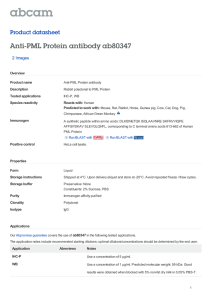
![Anti-PML Protein antibody [C7] ab96055 Product datasheet 2 Images Overview](http://s2.studylib.net/store/data/012095338_1-4868c878433c7243c74f795acef6727f-300x300.png)
